Are you working towards improving your engagement with customers and standing out in the competitive ecommerce world before the year ends? Email remains your best option!
Email marketing is the most effective approach to digital marketing. While there are more than four billion email accounts worldwide today, the channel has become the most professional and authentic way to get in touch with your customers.
How Do You Go About Using This Vital Communication Channel?
You start by creating solid relationships with your subscribers in preparation for converting them into customers. In this case, have an effective, segmented email list that can help you send more personalized emails relevant to your customers’ inboxes.
In addition, it’s also recommended to use a DKIM look-up, as it can help you ensure your emails are validated and delivered properly to your recipients.
Additionally, you need to send different emails in the various stages of your customer’s journey to address specific needs. Below are the different types of emails you should send to your potential and existing customers.
1. Welcome Emails
After signing up for your email list, the first message you should send to your subscribers is a welcome email. It provides you with an opportunity to engage with your new subscribers.
This email is your first impression and sets the experience of the client throughout their onboarding process. It is a good idea to include a “thank you” in your welcome email to appreciate the customers for joining your email list and personalize your greetings.
Moreover, do a proper introduction for your brand to familiarize your new subscriber with it. Let them also know of the offers you provide. This is a great promotional opportunity if done the right way! However, let your sales promotion be indirect.

Wayfair’s welcome email uses an alternating image and text approach. It makes it easily scannable by the reader and is visually attractive. The email promises new customers an easy shopping system with a free shipping offer for goods worth over $49.
To send automated welcome emails to new customers we recommend using Sender. With their endless list of features, you can grow your subscriber base and build long-lasting relationships with them. The tool provides you with beautiful templates, enables you to personalize messages, and ensures high deliverability, to mention but a few.
Here is how the Sender email design builder looks from inside:
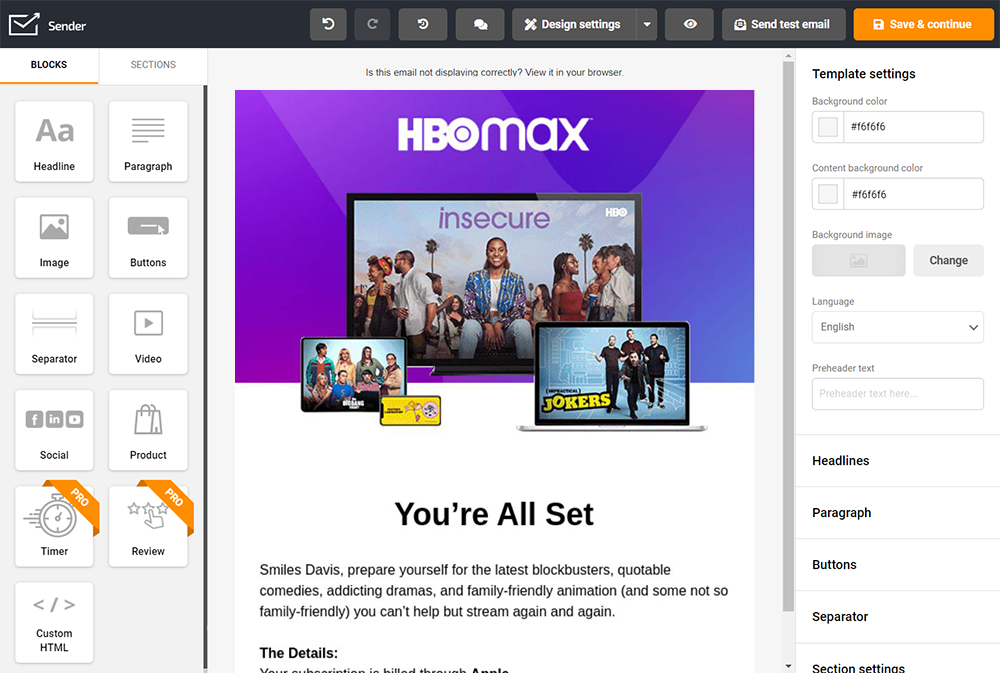

2. Lead Nurturing Emails
These are personalized, automated email campaigns that enhance a smooth customer’s journey throughout their buying journey. These emails carry essential information relevant to the particular stage the buyer is in the sales funnel. Make them less promotional!
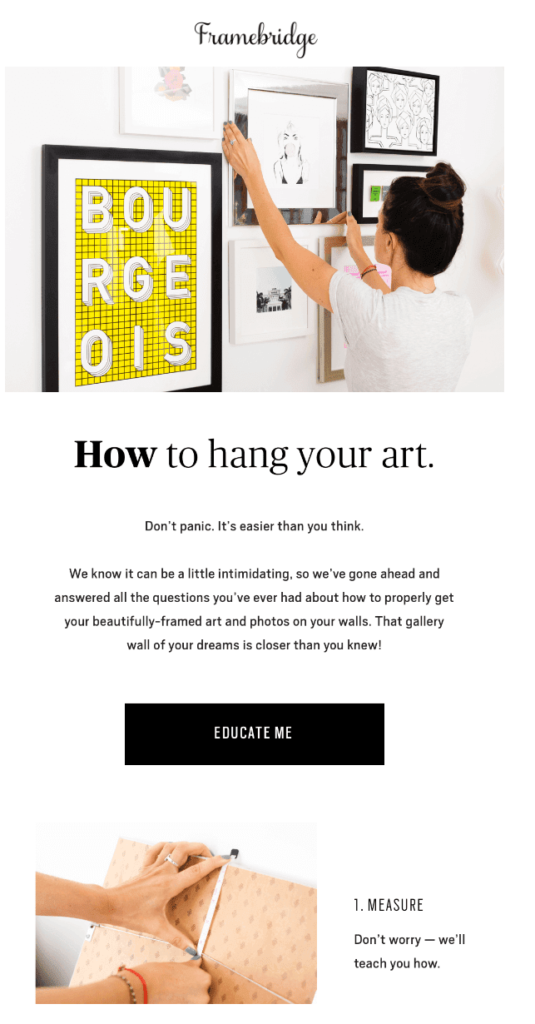

In this email, the brand educates the customer on how to go about rightfully placing framed photos. It addresses all the challenges that they would face in the exercise. This is a display of care and excellent customer service that encourages repeat purchases.
3. Promotional Emails
The focus of every marketer is to drive their customers to make some purchases from their stores. It’s necessary, therefore, that you send your clients promotional emails from time to time. These emails should include incentives such as discounts and coupons that inspire them to spend more on your brand.
In addition, segment your target group and apply personalization tactics to remain relevant in your audience inboxes. For instance, you can’t offer a discount to a customer immediately after buying the same product in full!
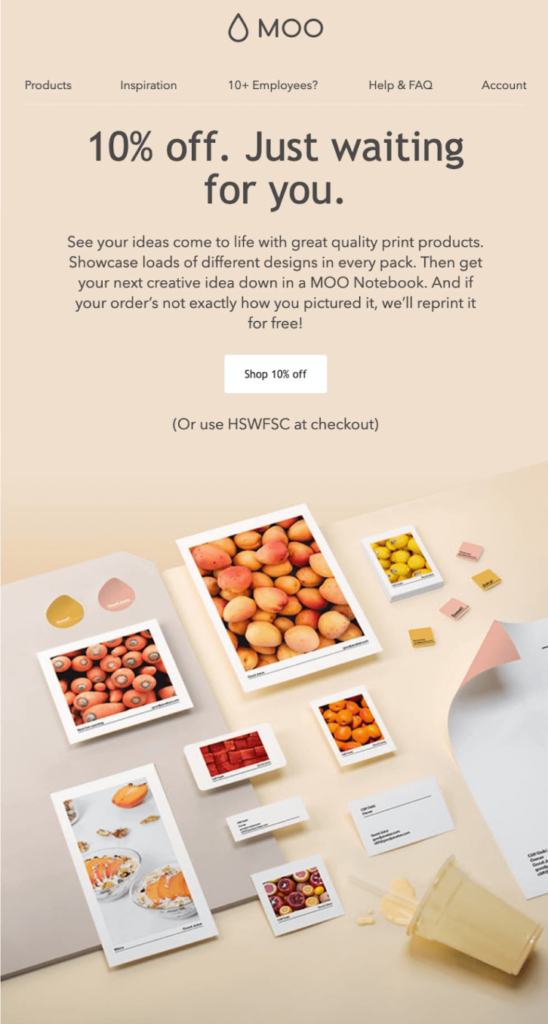

In this email example, the first thing the recipient will see at a glance is the 10% off the product price. It also assures the reader of quality services, and where they are not up to the customer’s expectations, the brand will do a repeat for free.
The strategy is effective in winning the trust of your customers as it eases anxiety!
4. Confirmation Emails
These are transactional emails you send to customers after clients successfully complete a particular task on your site. Your email may confirm an email list subscription, product purchase, shipping details, or booking confirmations.
These emails create an immediate bond between your brand and the customers.
This branded receipt carries a payment confirmation message and has relevant CTA and links. It aims to inform new subscribers that their order has been processed and the required services are now available.
5. Feedback Request Emails
You send these emails to customers requesting them to share their experiences after they engage with your product. Therefore, you need to give your customers enough time to use the product to provide informed feedback.
This information is vital as it helps offer improved services to your clients after identifying their likes and dislikes, and as a result, your sales scale up!
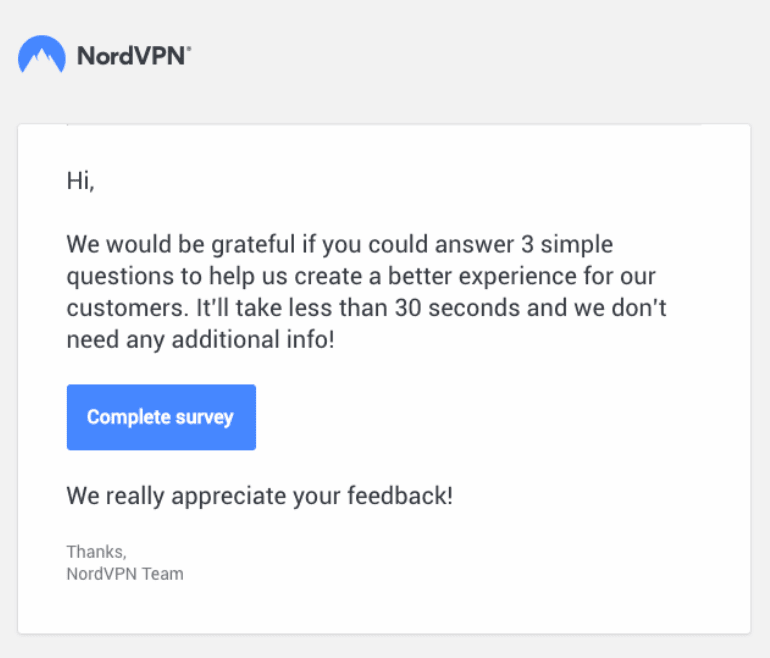

Thumbtack has a simple but straightforward feedback email that kicks off with a personalized salutation. It continues by thanking the recipient for being part of the brand’s community before requesting a response on their short survey. It indicates how the feedback is helpful to the brand and more so to the customers. All these key points make the email convincing enough.
6. Milestone Emails
These are emails you send to your customers reminding them of the value they get from your brand within a particular period. You could consider celebrating birthdays and anniversaries with your customers by informing them of the achievements they have made so far.
The email encourages a repeat purchase from these customers and thanks them for choosing you over your competitors.
Additionally, you can boost your thank you note by offering discounts on their next purchase, thus making them feel appreciated and part of your business.


The brand sends this email to remind the recipient of their initiation date. Such an email can excite the reader and inspire them to stick to the brand.
7. New Product Announcement Emails
Sending a new product launch notification to your customers is crucial. You send these emails to announce a new product release, feature update, or upcoming webinars and events.
Always ensure that your customers are the first ones to know whenever you have something new coming up. This gives a feeling of being part of your brand and, thus, owning it.


The brand uses a teaser email to alert its customers of the new product they are about to launch. This email attracts readers’ attention and makes them eager to know what will unfold on the “big” day.
8. Abandoned Cart Emails
These are the emails sent to customers who add items to online carts but failed to complete the checkout process. In your abandoned cart email, remind the customer of the things they left behind (include their images), use persuasive but polite language, and use incentives to inspire a comeback.
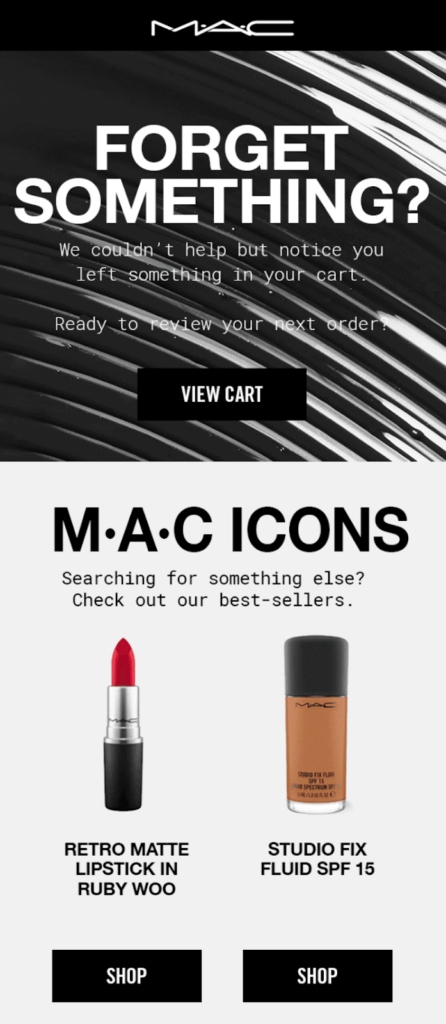

The brand sends a “friendly reminder” to the abandoners, encouraging them to complete their purchase. It also uses the platform to suggest other items that the buyer may be interested in.
9. Re-engagement Emails
These are marketing emails sent to inactive customers to get them on board once again. To avoid spamming your audience, you should remove those who don’t respond to your re-engagement email from your email list.
This email is very straightforward! It gives the recipient two options: to show interest by updating email preferences or unsubscribing from the brand’s list if they are not interested in receiving its content.
10. Follow-up Emails
These refer to one or several emails sent after a subscriber has taken a particular action on the website. You can send these emails to learn or clarify something, make a sale, or generate business. The email must be value-adding to your audience.
This follow-up email displays the brand’s commendable customer service. After they have responded to the customer’s request, they follow up to know if they met his or her expectations; this makes the customer feel valued such that they continue sourcing services from this brand.
11. Brand Story Emails
A brand story is a detailed summary of feelings and facts surrounding your brand. Brand story emails narrate the story behind the starting and progress of your business. The email also expresses how you are still pursuing the narrative to date.
While most customers are familiar with online relationships, sharing your brand’s unique story journey is a great idea. You can use photos, written content, or videos in your emails. This establishes strong bonds between customers and your brand.
The brand shares its success story of the Micro Puff Hoody, which is one of its products. To back up its story, the brand includes the awards received for the excellent performance of the product in the market. This builds the customers’ confidence in the brand!
Sending Relevant and Effective Emails to Your Customers This Year
An email is an essential tool in the world of eCommerce today, and your business is not an exception! Email marketing is the backbone of every successful business in remaining professional and relevant in their specific industries. Emails will also maintain a good connection between you and your customers. Hence, you can know them well, remain engaged, and as a result, you can easily convince them to keep buying from your stores. From these emails, you get feedback from your customers that can help you improve your brand and customer service. Consequently, you will scale up your sales revenue which is the core focus of any business.


Skirmantas Venckus
Skirmantas is a writer by day and reader by night. He hates talking about himself in the third person. He is also the growth hacker at Sender.net – the email marketing provider that is focused on user-friendliness, affordability, and utility.




